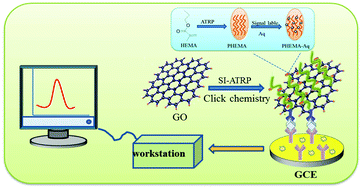Preparation of a novel sandwich-type electrochemical immunosensor for AFP detection based on an ATRP and click chemistry technique†
Abstract
It is extremely important to explore the synthesis methodology and application scope of functional polymer brush-based nanocomposites. In this work, an ultrasensitive sandwich-type electrochemical immunosensor based on a polymer brush/graphene oxide (GO) nanoprobe was designed for the quantitative detection of alpha fetoprotein (AFP). As the backbone of the polymer brush, polyacrylonitrile-g-GO (PAN-g-GO) was efficiently prepared via surface-initiated atom transfer radical polymerization (SI-ATRP). Benefiting from the large number of nitrile groups in PAN, the poly(vinyltetrazole-co-hydroxyethyl methacrylate)-g-GO (P(VT-co-HEMA)-g-GO) was synthesized through nitrile click chemistry. Furthermore, the immunosensor reached the design requirements of a high sensitivity as the P(VT-co-HEMA)-g-GO was connected to plenty of signal labels. Importantly, the designed immunosensor showed a wide range (2.5 × 101–5 × 104 pg mL−1) (R2 = 0.993) and a low detection limit (LOD, ∼0.183 pg mL−1) with a high selectivity, good reproducibility and excellent stability. Therefore, these polymer brush-based nanocomposites can provide potential applications for determining tumor markers (TMs) with robust signal amplification capability.



 Please wait while we load your content...
Please wait while we load your content...